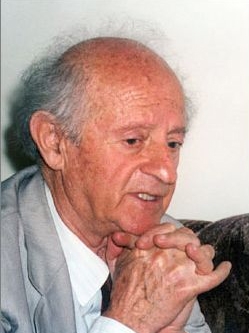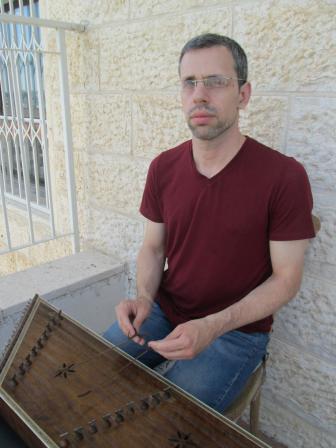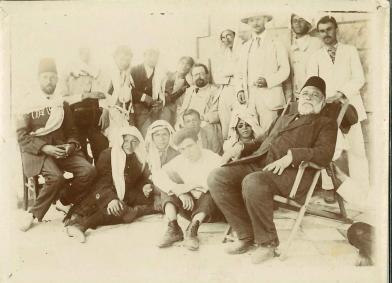Musicologist, folklorist and composer Nikolay (or Nikolaï) Yankov Kaufman (or Kauffman, Kaufmann) is considered as one of Bulgaria's foremost music scholars. Although the vast majority of his academic and artistic output was in the field of Bulgaria folk music, with strong emphasis on studies about plurivocality and rhythm, dedicated unfailing efforts to the documentation and study of the Jewish traditions of Bulgaria. Although his publications on these subjects (see list below) are few, their importance overshadows their number. A full evaluation of Kaufman’s contributions to the study of Jewish musical traditions is a desideratum because many of his materials (recordings and musical notations) are still unpublished.
Kaufman was born in the northern city of Ruse (Rousse or Rustchuk) on the Danube, the site of an important Jewish community, to an Ashkenazi family. As he relates in a 2006 interview with Lyudmila Parvanova, “two months later my parents settled in Gabrovo (northern Bulgaria) - at that time we were the only Jews in the town.” And he adds: “We lived a calm and peaceful life… [non-Jewish] Bulgarians loved us a lot and we answered them [reciprocated] the same way.” His maternal grandfather, Froim (Friedrich) Herschkovitch, moved to Bulgaria in 1875 from Kishinev and according to family history, he lived earlier on in small shtetls near Odessa. This important family information is embedded in Kaufman’s article on the music of the Ashkenazi Jews in Bulgaria (1990). There he adds that his grandfather “was a very religious man who spent most of his time reading and singing psalms from holy books. He loved to sing old songs in Yiddish…but his children never learned them. Only my mother knew part of his repertoire which, in her words, was a huge one indeed. And she probably learned the songs he used to sing most often.”
Kaufman’s mother, Ida Fr. Herschkovitch was born in 1895. She was an important source of information for Kaufman’s research on Ashkenazi song and may have been also an inspiration for him as she apparently also wrote a few articles: “The information I have gathered from my mother and from other relatives is hardly sufficient to make comprehensive conclusions about the songs of this relatively small group of people (compared to the Sephardic community). (Kaufman 1990: 197).
As part of the former Ottoman Empire, Bulgaria had a Sephardic majority consisting of descendants of immigrants who settled there in the aftermath of the late 15th century expulsions from the Iberian Peninsula. Sephardic Jews absorbed older local Byzantine Jewish populations and were joined by Ashkenazi immigrants “descending” from the north to Bulgaria from neighboring Rumania. Most Jews left Bulgaria after World War II. Kaufman dedicated efforts to record all Jewish ethnic and religious denominations in his country. From this perspective, his work is rather unique in its scope within the former “Eastern bloc” during the Cold War. It can be compared to that of the Rumanian Jewish ethnomusicologist Dr. Ghizela Suliţeanu.
In 1952, Kaufman graduated in trumpet and music theory from the National Academy of Music in Sofia. From 1952 to 1988, he worked at the Bulgarian Academy of Sciences' Institute of Art Studies, then moved to the Institute for Folklore Studies (today Institute for Ethnology and Folklore Studies with Ethnographic Museum) were he developed an outstanding sound collection of Bulgaria folk music that served as the basis for his numerous published studies. In fact, his work is one of the pillars of modern Bulgarian ethnomusicology. About his contribution Kaufman said in his aforementioned interview of 2006: “I've visited more than 2,000 Bulgarian villages and recorded more than 40,000 folklore songs, which are kept in the archives of the Bulgarian Academy of Sciences.”
In 1963, Kaufman participated in the epoch-making conference East Meets West, the 16th Conference of the International Folk Music Council held in Jerusalem. He delivered a lecture on the Sephardic musical traditions whose content heralded his later articled on the subject (Kauffman 1967). Only the abstract of this lecture was published (Kaufman 1964).
Kaufman was awarded a doctoral degree in Art Studies in 1973. In 1977 he was elected corresponding member of the Bulgarian Academy of Sciences and eventually was elected as Academic (2003). From 1978 he was a lecturer at the National Academy of Music and later on at the Free University in Varna. He was awarded several awards by the Bulgarian Academy of Sciences and Sofia University for his contributions to art and scholarship.
Kaufman's prolific output as a composer and arranger includes a selection of arrangements of the Ashkenazi and Sephardic folk songs from Bulgaria that he studied. Kaufman was also actively involved with the renowned Bulgarian State Radio and Television Female Vocal Choir, whose recordings under the banner of the title of its first album, Le Mystère des Voix Bulgares, are renowned worldwide. The second album of the choir (1988) went on to receive the Grammy Award for world music (1989). This album includes three arrangements by Kaufman.
We learn from Dr. Sabin Levi, Associate Professor of music theory and organ at the National Music Academy Professor Pancho Vladigerov in Sofia, Bulgaria, who followed Prof. Kaufman’s work closely and reported on it with some detail, that Kaufman prepared many arrangements of the Jewish songs he collected for various mixed vocal and instrumental ensembles. As far as it can be attested, these pieces were not yet published even though Levi announced that a large volume “is to be published soon.” In this “soon-to-be-published edition” songs are arranged by name (listed alphabetically), performance ensemble/number of voices, culture (Sephardic or Ashkenazic), and holiday or occasion (religious or secular). The songs are in Hebrew, Yiddish, Ladino and Bulgaria.
Also the extensive transcriptions of his Jewish field recordings that included liturgical music and songs for the year and life cycles remain unpublished except for those appearing as examples (in Kaufman’s handwriting) in the publications listed below. Kaufman started this collection when there were still in Bulgaria functioning synagogues, including modernizing ones, and a vibrant Jewish community.
However, in spite of the delay in the publication of large Kaufman’s Jewish opus, a sizeable selection of recordings based on it was released. Twenty-two songs in Ladino for voice with violin, flute and guitar accompaniment were recorded by the renowned Bulgarian actress and singer Eva Volitzer in a CD titled Jewish Sephardic Songs in Ladino/Canciones sefardies de Bulgaria released in 1996 in two parallel labels by the ARC Records label (EUC 1344) and by the Bulgarian label Musicautor.
Moreover, two choral arrangements of Ladino songs appear in the CD A Portrait of Nikolai Kaufman released by Riva Sound in Bulgaria in 2000 performed by Le Mystère Des Voix Bulgares. Choral arrangements in Yiddish, Ladino and Hebrew performed by various choirs and recorded on separate occasions also appear in Kaufman’s Jewish Music from Bulgaria (Sofia, Gega New, 1994; copy at the National Sound Archive of the Israel National Library, CD 02063) and the overlapping non-commercial release simply titled Jewish Music performed by the choir Cosmic Voices from Bulgaria, conducted by Vania Moneva (copy at the National Sound Archive of the Israel National Library). An earlier version of Jewish Music was published without date. Finally, Yiddish, Ladino and Hebrew songs performed by various choirs were released in the most recent (and last) production of Kaufman’s arrangements, the CD Shlof mayn kind: Jewish songs in Yiddish and Ladino published in 2015 by the label Vogue Vision in the USA. All in all, Kaufman attempted with these arrangements to integrate the Jewish heritage within the multicultural texture of the Bulgarian national music culture.
As Sabin Levi points out, Kaufman’s arrangements are rather complex. The choir is “often treated as an ‘orchestra’ (often with an added onomatopoeic text, glissandos, etc.) – these arrangements are definitely for a professional choir ensemble.” Some of the songs are without text, in the Hassidic niggun tradition. Rich harmonies, ostinati, modulations, double-leading tone cadences, rich ornamentation and modality characterize these arrangements.
Selected bibliography of Nikolai Kaufman’s writings on Jewish music
Kaufman, Nikolay. 1964. Jewish and Gentile Folk Song in the Balkan and its Relation to the Liturgical Music of the Sephardic Jews in Bulgaria. Journal of the International Folk Music Council 16, p. 63.
Kauffman, Nikolai. 1967. Muzikalniot folklor na spandskite (Sefardskite) Evrei v Bulgaria (The music folklore of the Sephardic Jews in Bulgaria), Bulletin de l’Institut de Musique (Academie Bulgare des Sciences) 12, pp. 231-267.
Kauffman, Nikolai. 1985. The folk songs of the Bulgarian Jews in the past, Annual of the Social, Cultural and Educational Association of the Jews in Bulgaria 20, pp. 111-143.
Kaufman, Nikolai. 1990. The Folk Music of the Ashkenazi Jews. Annual. Organization of the Jews in Bulgaria “Shalom” 25, pp. 197-205.
Kauffman, Nikolai. 1993. Jews and the Balkan Urban Songs. Annual of the Social, Cultural and Educational Association of the Jews in Bulgaria 28, pp. 184-209.






